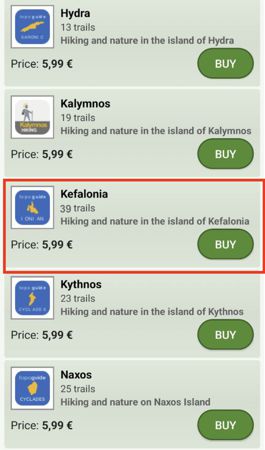Monasteries of Kefalonia
Cultural and historic outline of Kefalonia
Monasteries of Kefalonia
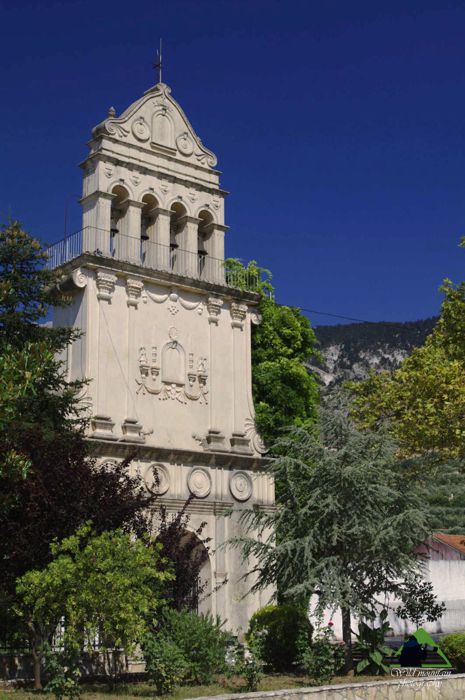
The belltower of Agios Gerasimos monastery
More than 20 monasteries were founded, flourished and declined or still shine in Kefalonia. The article presents with descriptions, images ad precise cartography the most important monasteries of the island, such as Agios Gerasimos monastery, the Agii Fanentes monastery.
Ο χάρτης επισημαίνει και τις μονές Ιρίων, Αγίου Διονυσίου, Εσταυρωμένου, Κεχριώνος, Κορωνάτων, Υπαπαντής, Ζωοδόχου Πηγής και Παναγίας Λάμιας.
Agios Gerasimos monastery
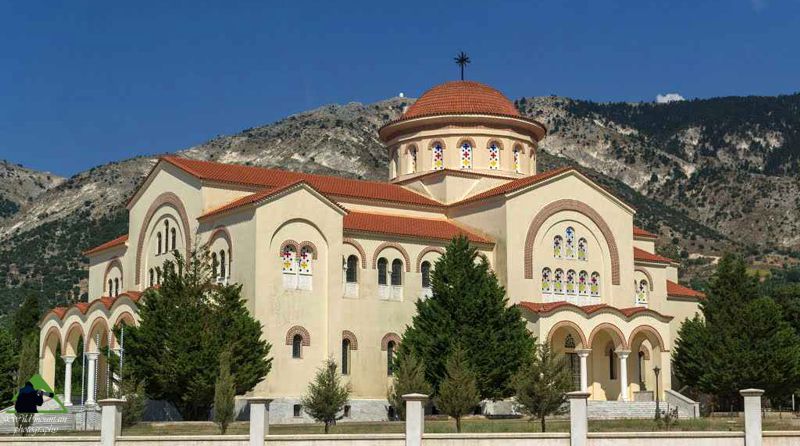
Agios Gerasimos monastery
The monastery of Agios Gerasimos is the most important religious monument of the island. It has been established in 1560 by Agios Gerasimos, patron saint of the island, on the plateau of Omala. Inside the church of the monastery there is an entrance to the hermitage of Agios Gerasimos, a vault divided two rooms. The monastery has a huge turnout of visitors and faithful, and the name Gerasimos is the commonest name in the island and an evidence of origin from Kefalonia.
Agii Fanentes monastery
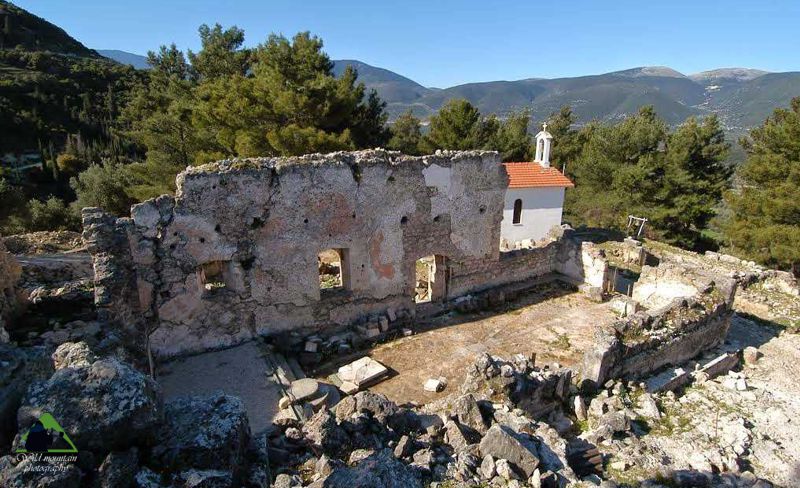
The ruins of the old monastery of Agii Fanentes
The monastery of Ahii Fanentes was founded on the ruins of a old temple of gnostikos Epiphanes. The monastery is dedicated to the memory of saints Gregory, Theodore and Leon, who came from Anatolia and lived in the 2nd or 3rd c. AD.
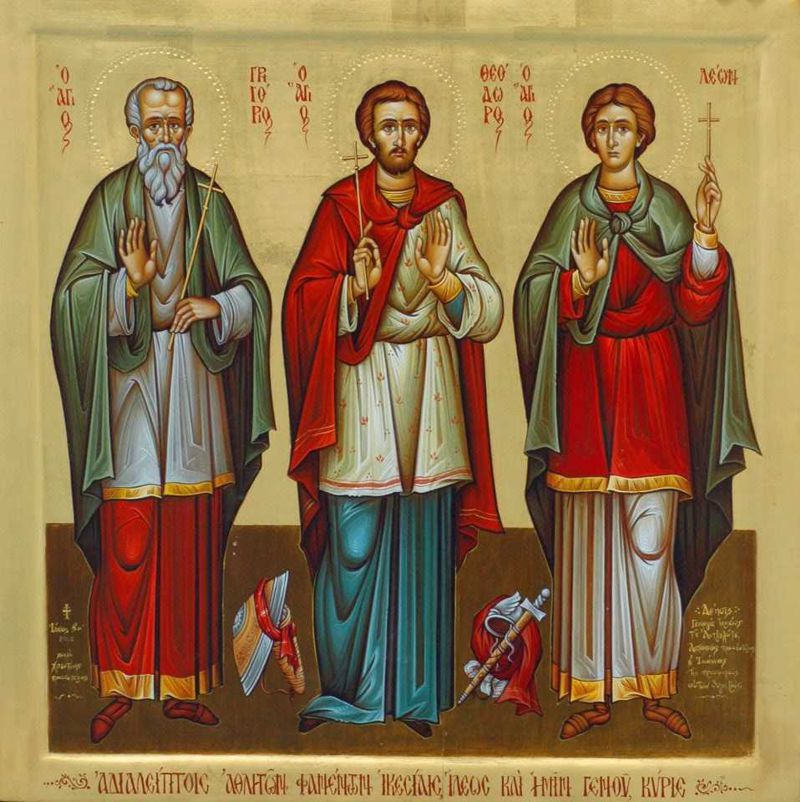
Agii Fanentes (Grigorios, Theodoros and Leontas depicted as saints)
There is no evidence about the period where the monastery was founded. However, it is known that during a great restoration in late 17th c., material from the ruins of the nearby ancient acropolis Sami were used. The monastery was already deserted for centuries, when was completely ruined by the earthquake of 1953. The memory of Agii Fanentes are still alive in Kefalonia: in Sami, ceremonies are performed in their honor on the day of Agii Pantes (All Saints).
Panagia Thematon monastery
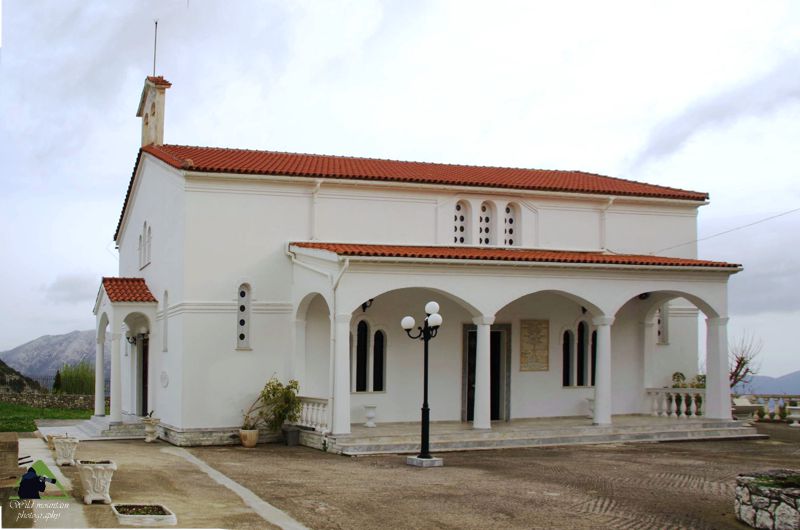
The newer chapel replacing the katholikon of the Panagia Thematon monastery
The Panagia Thematon monastery is located on the eastern slope of Agia Dynati massif, in a short distance from Agia Efimia and in a beautiful location with numerous tall kermes oaks. Its foundation dates to the end of the 10th century and had been a monks’ monastery (without any monks nowadays). The building complex, however, is well preserved and there is care for the adjacent infrastructure. The visitor can take a tour within the area and admire the icons in the main temple and the chapel of the monastery, as well as the embossed depictions on the church bells. The monastery celebrates at Easter Tuesday, with the litany of Virgin Mary image and a feast in the neighboring kermes oak forest, where there is recreational space.
Monastery of Agios Nikolaos Grouspas
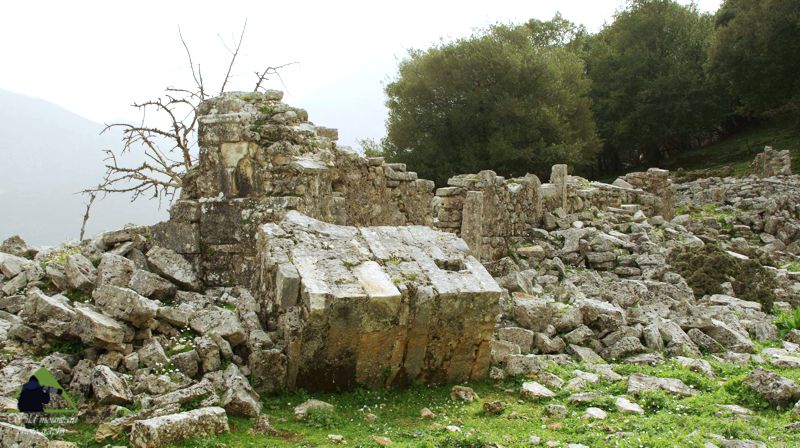
The ruins of Agios Nikolaos Grouspas monastery
The monastery of Agios Nikolaos was built between the 16th and 17th century and was abandoned in the early 19th century. Nowadays, only the ruins of the stone buildings are found here, while the southern wall of the temple and parts of the bell tower can be distinguished with careful observation.
Sision monastery
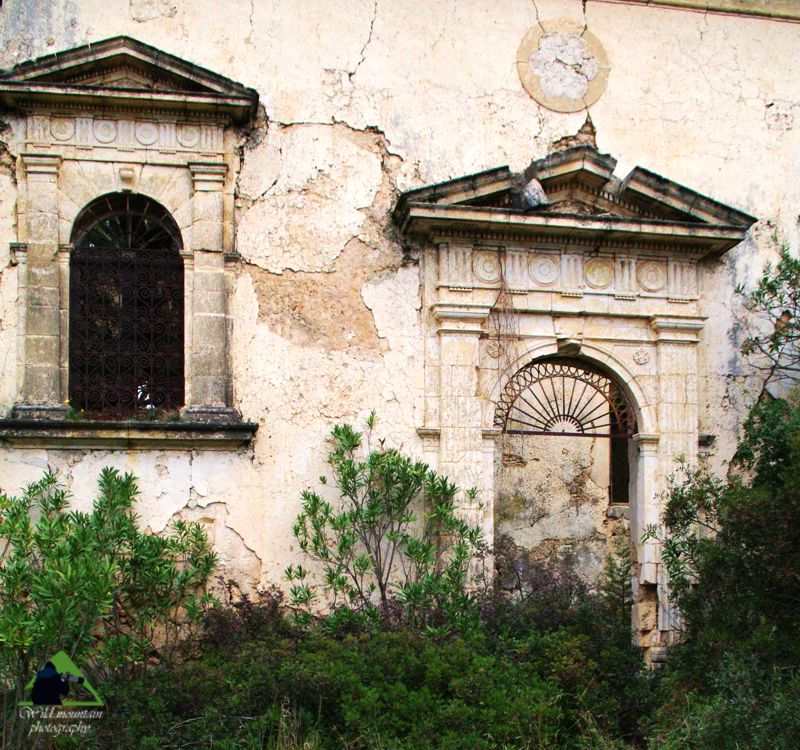
The monumental gate of the Old Sision monastery
Sission monastery was founded in the 13th century, probably by Francis of Assisi, in a nice seaside location. The reference to Assisi is based on assumption of similarity between the two place-names (Assisi-Sissia). Sission monastery was originally a catholic monastery and belonged to the Latin Diocese of Kefalonia, but later became an orthodox monastery.
The monastery is dedicated to the Virgin Mary (local people call it "Lady in Sissia"). The image of Our Lady of the monastery, a work of the 15th c., is transferred annually with a procession to the temples of the Castle and returns to Sissia again one month later.
A few dozen meters further north, a single monk runs the small New Sission monastery.
Kipoureon monastery
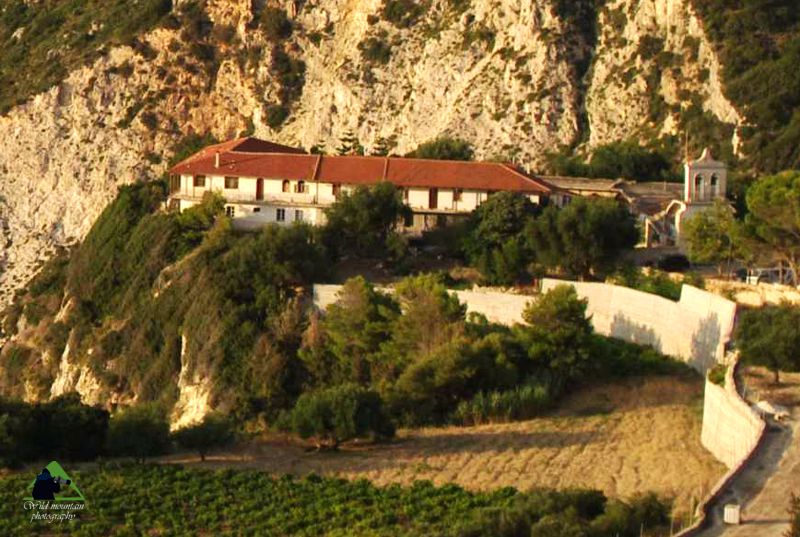
The Kipoureon monastery
Once a significant monastic complex of Palliki, the Kipoureon monastery was founded in 1759 by archimandrite Ch. Petropoulos from Paxi. The monastery was organized around a smooth zone at the edge of the large natural slope of the western coast. The place was suitable for cultivation, and the performance of the monks in agriculture gave the monastery its name: Kipoureon, that is “of the gardeners”, in Greek.
The Kipoureon monastery had been a multitudinous men community, which reached 80 persons, monks and staff, at its flourishing times. It suffered successive disasters by the earthquakes that hit the island and from time to time had been abandoned. Today it is maintained by the sole monk living in the monastery.
The katholikon is dedicated to the Annunciation of the Virgin Mary and celebrates at March 25th. A special liturgy takes place on the day of Agia Paraskevi, as the homonymous icon from the nearby, now ruined, monastery of Agia Paraskevi Tafiou is also kept here.
Agia Paraskevi Tafiou monastery
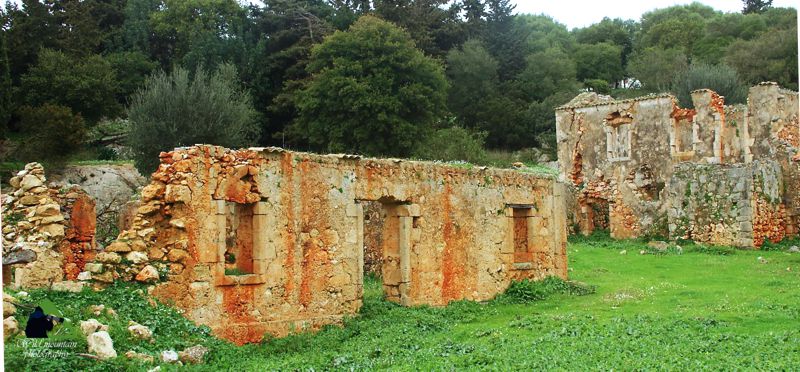
The ruins of Agia Paraskevi Tafiou monastery
Agia Paraskevi Tafiou monastery is located on the western side of Paliki, very close to the Kipoureon Monastery, with which it was organically connected. Its location is surrounded by olive groves and stock farms. Only ruins remain from the old buildings of the monastery, on the walls of which a careful observer will notice shell fossils. The unique heirloom of the destroyed monastery is the icon of Agia Paraskevi, which is kept nowadays in Kipoureon Monastery. A new temple has been built in the area, which remains unmortared and unpainted. The monastery celebrates on July 26th.
Panagia Anatolikou monastery
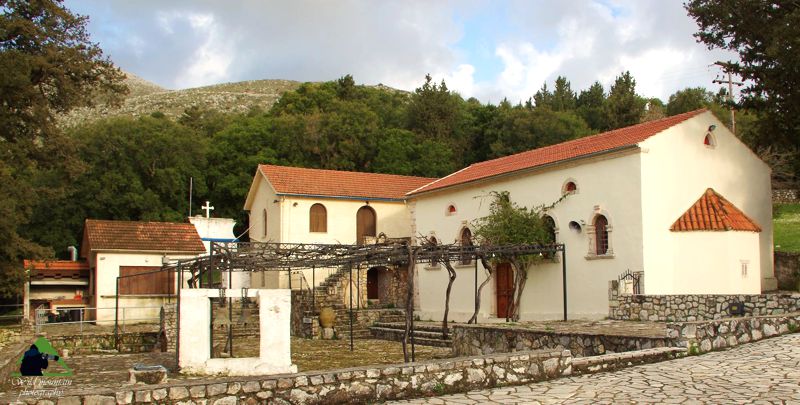
Panagia Anatolikou monastery
The Panagia Anatolikou monastery is located on the eastern slopes of Kalon Oros, just before Neochori, in a location with tree vegetation (cypresses, kermes oaks-trees, almond-leave pear trees, wild olive trees) and an exceptional view to Ithaca.
In the wider area of of the monastery the three stone-built threshing floors stand out, maintained in very good condition. The monastery enclosure is neat and paved, while the building complex is plainly constructed and obviously modern, considering that the monastery is said to have been founded in the 12th century.
The monastery celebrates on the 15th of August with a big fest, with people coming from all the villages of Pylaros.
Agios Anthimos and Agia Paraskevi monastery near Lepeda
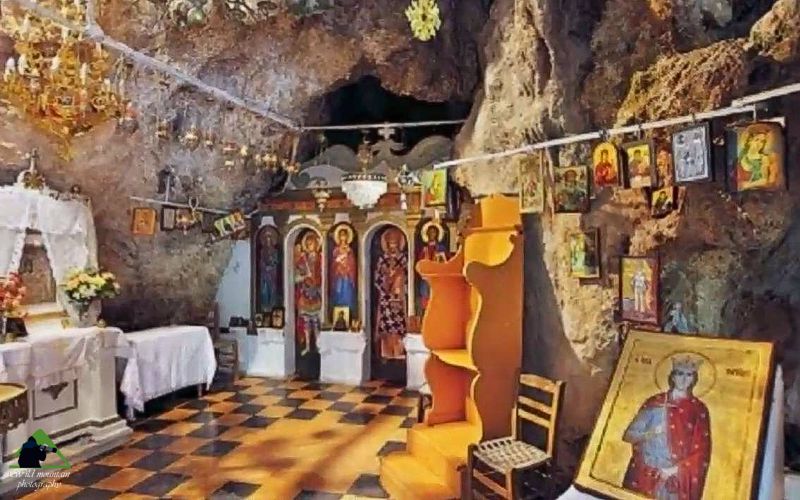
The cave of the Agios Anthimos and Agia Paraskevi monastery
A small men monastic community of the 17th century. The katholikon was built within a cave and was dedicated to Agia Paraskevi. The monastery was destroyed during the earthquakes of 1776 and was reconstituted as a woman monastery a few years later by Cephalonian missioner Anthimos Kourouklis. The monastery experienced days of prosperity until the earthquakes of 1953, when both the cells and the walls of the Catholic collapsed: the monastery was then abandoned and operates only as a church.
The cave suffered damage also in the last earthquake in 2014. Today's buildings are modern (only part of the gate of the old monastery survives).
Μονή Θεοτόκου Άτρους
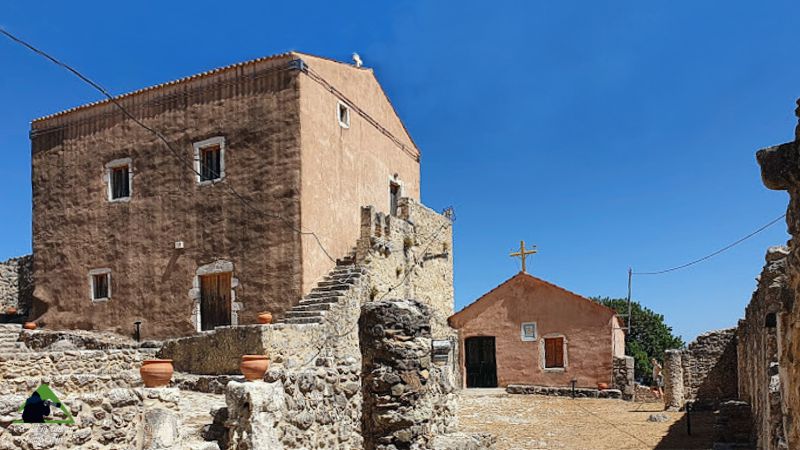
Η μονή Θεοτόκου Άτρους
The monastery of Panagia Atrous is built on a rocky plateau of Mount Atros, at the elevation of 540 m.
It is believed that the monastery was founded in the 8th century - based on this dating, it is the oldest surviving religious monument on the island. The complex consists of the katholicon, the archontikon, an auxiliary building and a remarkable defensive tower. The katholicon is dedicated to the Nativity of the Virgin and celebrates on September 8. The monastery hosted a men community.
The site of the monastery is not visible from the vulnerable shore of Poros. Moreover, the site is naturally defended, while having access to a small agricultural zone and the restricted yet interesting forest and livestock resources of Mount Atros. The storage of rain water from the roofs of the buildings, as well as the small springs in Oxo Lakkos and Vathylakkos plateaus, allowed the monastery to have a certain autonomy in water resources, an element that strengthened its defensive capacity. The path from the monastery to the top of Mount Atros is still quite clear.
The monastery is deserted, but the buildings have been restored and are kept in excellent condition. On the annual celebration of the monastery, a ceremony and relevant festivities are held.
Paliochersou monastery
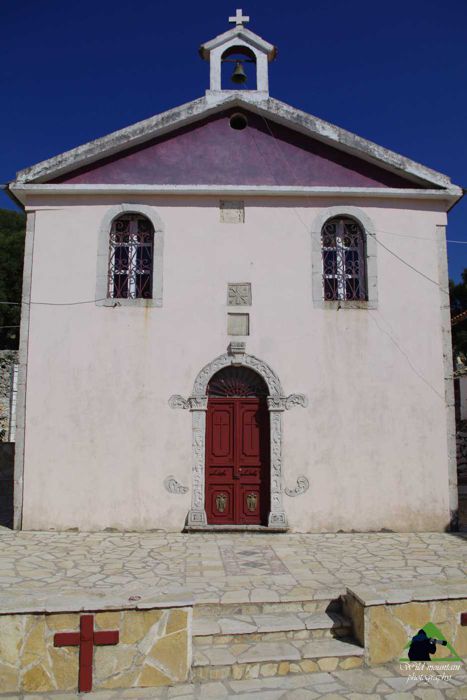
The katholikon of Paliochersou monastery
The monastery of Panagia Paliochersou was founded in the late 15th century. Isolated in the heart of Eryssos, it has passed through periods of prosperity and decay. In 1907, when the last monks died, the monastery deserted. It suffered significant damage from the earthquakes of 1953, but it was completely renovated recently and remains among the beloved pilgrimages of the mountain villages on the peninsula.
Theotokos Agrilion monastery
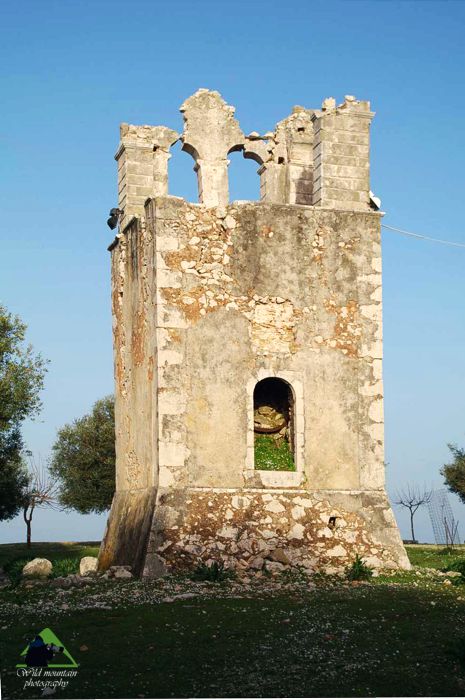
The belltower of Agrilion monastery
The Agrilia monastery was founded in the 18th c. according to local tradition by two shepherds, who became the first monks. The monastery occupies the smooth flat area on the ridge between the bays of Sami and Antisamos; its position oversees the entire region. Apart from the bell tower, belonging to the initial phase of the monastery, the rest of the buildings and the katholikon are surrounded by a low enclosure. The monastery preserves the old image of the Our Lady Agriliotissa.
Milapidias monastery
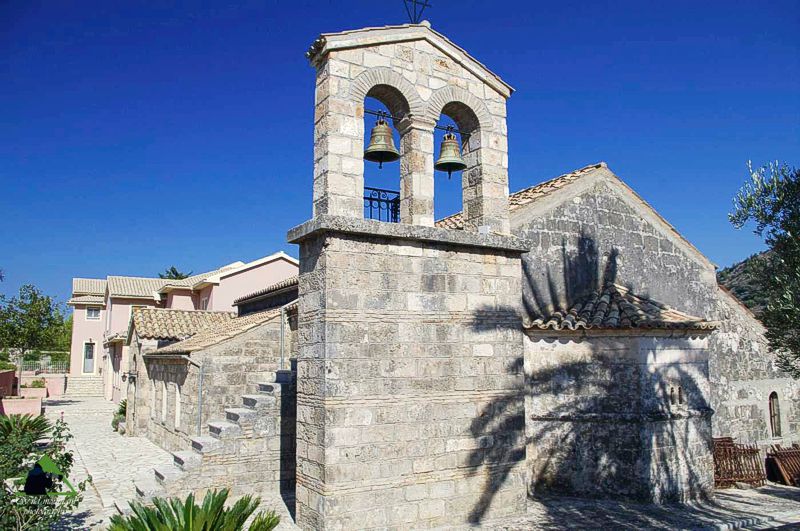
Taxiarches, a dependency of the Milapidias monastery
Milapidias monastery was named after the "milapidia" tree, an hybrid betweεn apple and pear. The monastery is first mentioned in 1264. The old church, dedicated to St. Andrew, preserve an old iconostasis of the 17th c. and hosts the Ecclesiastical Museum of Kefalonia. The monastery is now a female monastery. Inside the courtyard are four chapels, of which the most important is that of the Taxiarches (Archangels).

topoguide Greece
Kefalonia hiking,
nature and cultural guide
The guide Kefalonia topoguide is available for Android devices along with dozens of other regions of Greece, within the general application topoguide Greece. Kefalonia topoguide is a member of the Greek Islands group. Get Kefalonia topoguide as an in-app purchase from the topoguide Greece available regions list.
The Kefalonia topoguide guide is also available for iOS devices (iPhone and iPad) through the general hiker application Topoguide Greece. Get Kefalonia topoguide as an in-app purchase via the available regions list.
It is very interesting that topoguide Greece has the ability to simultaneously display up to 15 different areas, thus allowing an overall view of the Greek Islands and the easy alternation of hundreds of hiking routes, hundreds of Points of Interest and dozens of pages of the guide with innumerable photos.
